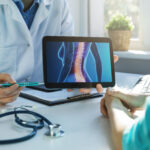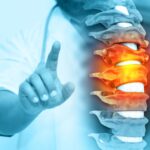
Cervical Stenosis
As we age, the intervertebral disc undergoes water content reduction, diminishing its shock-absorption capabilities. Initial changes occur in the disc’s outer ring, the annulus, resulting in tears. These tears might emerge without noticeable symptoms or causes, healing by forming scar tissue.
Scar tissue, however, is weaker than normal tissue. Repetitive injuries and tears accelerate disc wear and tear. As the disc’s sponginess diminishes, its shock-absorbing function declines.
Continued wear leads to disc collapse, causing a reduction in intervertebral space. This alteration affects the alignment of facet joints (the joints along the spine’s rear that allow motion of the spine). This deviation, akin to other joints in the body, imposes abnormal pressure on the articular cartilage covering the facet joints. Over time, this increased stress prompts wear and tear (osteoarthritis) of the facet joints.
Subsequently, bone spurs may form around the vertebrae and facet joints. These spurs can press against the spinal cord, resulting in myelopathy symptoms as discussed earlier. Alternatively, the spurs might exert pressure on nerves as they exit the spinal canal, giving rise to radiculopathy symptoms.
The cumulative impact of bone spurs, bulging discs, and thickened ligaments elevates the risk of compressing the spinal cord within the spinal canal.
The symptoms of spinal stenosis vary based on whether pressure affects spinal nerve roots or the spinal cord. Pressure on spinal nerve roots (radiculopathy) generally induces symptoms in the neck and arms. In contrast, pressure on the spinal cord (myelopathy) can influence both arms and legs.
Radiculopathy, arising from nerve root pressure, generates distinct sensations from spinal cord pressure. Irritated or inflamed nerve roots can trigger sensations of pins and needles, along with deep, dull aches or sharp shooting pains. Muscle weakening may also occur in the muscles controlled by the affected nerve root.
More concerning is pressure on the spinal cord (myelopathy), which can lead to permanent damage. Myelopathy symptoms encompass numbness or weakness in both arms and legs, loss of muscle control in the legs causing spasticity, and diminished “position sense” affecting limb awareness. This impairment can make arm, hand, and foot usage challenging and disrupt normal bowel and bladder function.
Accurate identification of the precise cause of neck pain often necessitates various diagnostic tests. Initial steps frequently involve standard X-rays taken at the doctor’s office, including angled and flexion-extension views. If necessary, additional tests like MRI scans may be conducted.
Conservative treatment options comprise epidural steroid injections (ESI) or nerve blocks and physical therapy.
Surgical interventions may involve laminectomy, discectomy, or corpectomy.

Book an appointment
"*" indicates required fields










